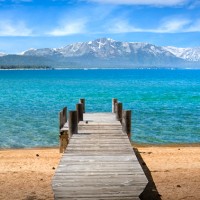White House announces more federal aid for Lake Tahoe region
Today, President Obama will speak at the 20th Anniversary of the Annual Lake Tahoe Summit about the importance of partnerships and innovation in tackling our shared climate and conservation challenges. The visit builds on other recent announcements, including the 100th anniversary of America’s National Park Service, last week’s designation of the Katahdin Woods and Waters National Monument in north-central Maine, and the expansion of the Papahanaumokuakea Marine National Monument to create the world’s largest marine protected area off the coast of Hawaii.
Like the President’s visit to the Alaskan Arctic last summer and Yosemite National Park earlier this summer, this visit to the Lake Tahoe region provides another vivid example of the new challenges we face as climate change threatens communities and ecosystems through impacts like increasingly frequent and severe drought and wildfires. In 2015, Lake Tahoe experienced its warmest average surface water temperature ever recorded and the west struggled with what may be the worst drought in more than 1,500 years. In keeping with the unique history of collaborative and innovative conservation efforts that have surrounded the Lake Tahoe region for more than two decades, today’s announcements include a series of commitments to build upon the successful conservation legacy at Lake Tahoe, boost innovative approaches to conservation, and address threats to vulnerable communities at another of the region’s key water bodies, the Salton Sea.
At the first Lake Tahoe Summit in 1997, President Bill Clinton – joined by Senator Reid as well as other key leaders from Nevada and California – jumpstarted a two-decades-long, successful partnership to restore Lake Tahoe’s legendary water quality, and strengthen the region’s economy for future generations. Since then, Federal, State, and local government partners have invested more than $1.8 billion into projects to restore wetlands, build transit facilities, upgrade roads to reduce polluted runoff, and reduce fire risks from nearby forests. Today, the Administration is building on this commitment with a number of conservation-focused actions impacting Lake Tahoe:
- Providing Hazardous Fuel Reduction Funding and Reducing Wildfire Risk: The Department of the Interior is announcing $29.5 million dedicated for hazardous fuels reduction projects to improve forest health and protect life and property from the threat of catastrophic wildfires. The funding will be used on public and private lands to support the removal of standing dead and dying hazard trees along roads and in campgrounds, administrative sites, communication sites, and the wildland urban interface – adjacent to community infrastructure – in or adjacent to the Tahoe Basin. Since 2002, the Department of the Interior has invested more than $400 million in funding for over 400 projects in the Lake Tahoe Basin that support hazardous fuels treatments, restoration work and the acquisition of environmentally-sensitive lands.
- Investing in a Public-Private Partnership to Improve Watershed Health: The National Forest Foundation – working together with the Department of Agriculture’s Forest Service and local community partners – is announcing that it has raised over $4 million for forest health, sustainable recreation and creek restoration projects throughout the Truckee River Watershed. This investment will increase the pace and scale of restoration in the region by expanding this effort to include adjoining watersheds as well as providing assistance in forming and facilitating the Tahoe West Collaborative.
- Supporting Improvements in Clean Water Infrastructure and Invasive Species Prevention: The Environmental Protection Agency is announcing more than $230,000 in grant funding for infrastructure to manage and reduce stormwater runoff in the region. The money will improve water quality in Lake Tahoe, which has been degraded by pollution from decades of uncontrolled stormwater runoff. In addition, the Fish and Wildlife Service is announcing nearly $1 million for eight projects to prevent the spread of invasive zebra and quagga mussels from nearby water bodies to Lake Tahoe. These invasive mussels could disrupt the natural balance of the Tahoe Basin ecosystem by degrading water quality and significantly reducing habitat for native species.
The rest of the fact sheet is here.
(Photo: Olof Carmel)

